How to make a sewer well: do-it-yourself installation and installation
Owners of private homes most often have to independently equip local treatment facilities at their site. It’s cheaper and easier to install sewer wells in the form of a regular cesspool or sealed storage. Properly arranged sewage treatment or storage station will do the job perfectly. Do you agree?
Here you will find out what materials are used in the construction of treatment facilities and drives for independent sewage. We have described in detail the construction technology of typical sewer wells. Based on our recommendations, it will be easier for you to decide on the best option for price and effort.
The content of the article:
The place of the sewage well in the sewer system
Often, a centralized sewage system in the private sector with low-rise buildings is simply not available. And it is necessary to get rid of domestic drains, not to pour them on the ground. For this purpose, an autonomous sewage system is being built, including the inside and the outside.
Domestic sewage collects wastewater from plumbing fixtures, and its outer part is intended for their disposal or accumulation for the purpose of subsequent pumping with wastewater. Receiving drains storage well on the street is the end point of the local export cleaning system.
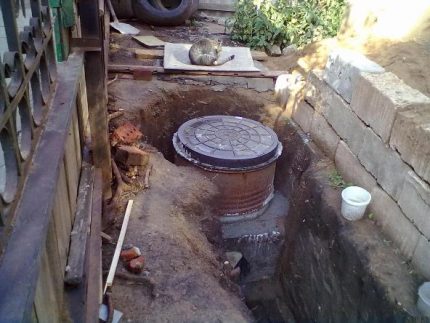
Fecal effluents in the sewer well are clarified, as a result of which partially purified water and suspensions are formed. In the case of a cesspool, the first is drained into the soil, and the second is decomposed by microorganisms to a state of silt that is safe from a biological point of view.
If the option with a drive is selected, then the sewage is simply collected in a sealed container, and as it is filled, it is pumped out with the help of a cesspool machine.
Of course, you can install full septic tank with several cleaning chambers, but it costs a lot. For a small cottage or cottage, where a family of three or four people lives, a storage tank or a cesspool for several hundred liters is enough. There are not many drains, a similar recycling system will cope with sewage without any problems.
Fermentation and clarification of wastewater can be carried out in one or more series-connected tanks. However, in the second case, the installation of sewer wells is greatly complicated.
It is easier to equip one well structure, and to accelerate the cleaning process, add chemical or biological reagents to it.
Most often, on their own site, the owners of private houses make a cesspool. But if the groundwater level is high, then the option with a cesspool is not suitable, you have to install a storage tank. Moreover, its volume is selected large enough to reduce the number of calls of vacuum trucks.
The decomposition of the biological component of sewage in the cesspool occurs due to anaerobic microbes. They do not need oxygen replenishment for life, so they will not need to install additional aerobic plants in the well. The entire cleaning system turns out non-volatile, not requiring an electrical connection.
All the processes of decay inside the sewer well occur naturally, thanks to bacteria living in the soil. They are quite successful in this matter, but anaerobes “work” rather slowly. Therefore, in order to speed up the processes, sometimes add bioactivators.
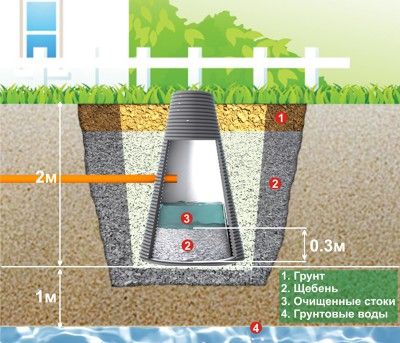
Requirements for the installation of such facilities
All sewerage should be mounted according to a pre-developed plan, which indicates the layout of all elements of the system and the building materials used. Its outer part in the case under consideration consists of pipe drains taking away from the house and a treatment plant.
Design and installation of sewer wells is regulated in the following regulatory documents:
- SP 55.13330.2016 “Residential single-family homes ...”;
- SP 32.13330.2012 “Sewerage. External networks ... ".
If you do not comply with the requirements specified in them, then the sewage system after assembly may simply be inoperative.
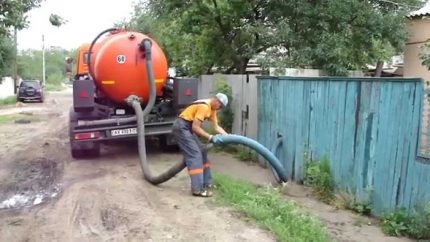
Structurally, the sewer well consists of:
- necks with a cover or a hatch;
- mines in the middle part (working chamber);
- bottom (draining or airtight depending on the option chosen for installation).
Even similar elements of this design can vary greatly in size and shape. Here a lot depends on the material of manufacture and design features of the treatment plant, as well as the volume of the tank.
What can a sewer well be built from?
Completed well construction can be from a variety of building materials.
When choosing the best option, you must consider:
- Climatic conditions (maximum possible and average temperatures, total values of rainwater and snow).
- Soil characteristics (freezing depth, composition and water level).
- Land features of the site.
If the soils are very heaving, then the sewage well should be made of the most durable building materials. And for wet soils will have to choose the most moisture-resistant option.
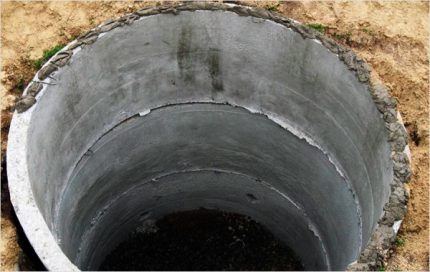
With your own hands, a sewer well can easily be made from:
- brick and stone;
- monolithic concrete;
- reinforced concrete rings;
- prefabricated plastic designs
- old tires.
The cheapest thing for self-installation will cost brick drain pit or a septic tank assembled from factory or homemade concrete rings.
But in the first case, you will have to tinker with the masonry, and in the second, lifting equipment will be needed. It is not recommended to manually lower heavy concrete products into the pit; they can be destroyed if it is broken and hit hard.
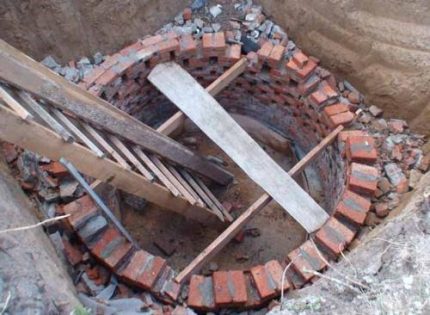
Concrete monolithic option will require the arrangement of formwork and preparation of the solution. If the latter is ordered already mixed in a concrete mixer, this will lead to a serious increase in the cost of work.
Structures made of plastic (polyethylene or PVC), fiberglass and polymer sand are quite expensive. But they are durable and extremely easy to install with their own hands. Such products weigh a little, a couple of people are enough for their installation.
From the used tires will come a very cheap sewer well. They stand in the tire penny, and you can pick up tires in a landfill for free. But here is the same problem as in the case of brick.
To make such a building airtight is extremely problematic, and it is almost impossible to repair. Absorbing well you can arrange from them, but the drive is no longer there.
You will learn all about choosing a tank for a storage sewer well for independent sewage from the article we submitted.
Choosing the location and volume of the tank
When installing a sewer well, a number of sanitary and construction requirements should be observed. If this is not done, then the risk of biological pollution increases. The situation can be reduced to an outbreak of infections, which threatens the owner of the cottage with serious problems.
Sewer well installation should be carried out at a distance from:
- fruiting trees and beds 3 m;
- foundations of buildings on a personal plot of 4–5 m;
- roads and underground utilities (gas, water, electricity) 5 m;
- wells for drinking water and water bodies of 30 m.
A slight deviation from these figures is possible only when installing a sealed storage tank or when installing a cesspool with powerful concrete walls with reliable external waterproofing.
In the case of an absorption well, water that has passed through a sand and gravel multilayer filter should enter the underlying soil layers away from buildings, communications, drinking wells, all types of reservoirs and private pools.
Observe distances so as not to change the composition of groundwater for the worse, not to pollute water bodies with insufficient cleaning, and not to wash out the underlying base from under building structures and utilities.
However, if the well structure for sewage drains is removed too far from the house, then the pipeline between them will have to be arranged inspection (inspection) wells every 10-15 meters, which will lead to additional considerable expenses. But this will have to be done, otherwise if the pipe is clogged, it will be necessary to open the soil in order to clean it corny.
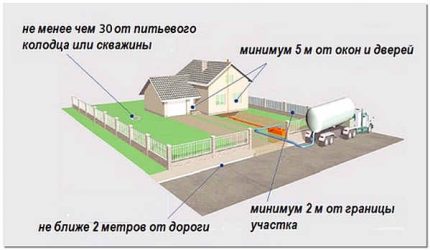
It is recommended to select the volume of the drainage sewer well by SNiPs at the rate of 600 liters for each person living in the house (200 daily liters of sewage multiplied by three days). With this capacity, the cesspool will have time to clarify the water, and the soil will take purified water.
With the storage capacity, the situation is somewhat different. It should be large enough so that there is a gap of a couple of months between calls by the scavenger. However, installing an excessively capacious tank is also not worth it.
The best option is a little more than 3.5 or 5 cubic meters. Drains from a similar capacity completely fill the barrel with a sewer machine. You have to pay for a call, not a cubic meter.
Installation and Installation Rules
When installing a well structure for external sewage, it is necessary:
- Dig a pit with a width of 30–40 cm wider than the selected structure.
- Tamp at the bottom of the pit a sand and gravel pillow of 15–20 cm.
- Mount the elements of the well.
- Lay and connect the sewage pipe from the house.
- Perform leak test of joints.
- Install a ventilation riser.
- Backfill and insulate.
Outdoor sewage pipe can be plastic, cast iron, ceramic or asbestos-cement. It should be laid at a slight slope to the well. Drains should drain into it unhindered by gravity. And the less horizontal bends the pipeline has, the better.
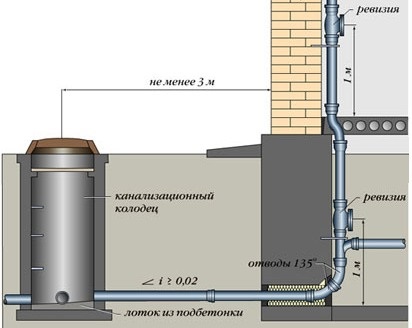
Pipe products made of cast iron and asbestos cement have rough walls, their slope needs to be slightly increased. In general, only a highly competent engineer can correctly calculate the required diameter and slope of the laid pipelines.
It is necessary to take into account the material of the pipes, the volume of effluents and their speed. It is best to entrust the design of the entire sewer system to a professional, and then installation can already be done with your own hands.
The installation of the sewer well should be carried out in such a way that its cover rises 15-30 cm above the ground. In rains and floods, under no circumstances should water enter the tank from the outside. This will instantly lead to its overflow and failure.
As warming in warm regions, there is enough soil half a meter thick over the main body of the well and a small layer of thermal insulation on the cover. In the northern regions this will not be enough, it will be necessary to cover the entire engineering structure with polystyrene. He is not afraid of moisture and frost.
Option # 1: concrete ring structure
Sewer well from reinforced concrete rings easy to install and unpretentious in operation. It is only necessary to carefully seal the joints between the rings with concrete mortar, and also cover the walls of the casing with a bitumen-based coating on the outside.
The main thing during installation is to make the rings on each other exactly without displacements. Otherwise, gaps will form in the walls, which can no longer be tightly closed. A pit for a cesspool can be dug right away in full depth and then lowered there.
And a variant is possible with the installation of one of the concrete products first and the production of a gradual digging under it, with the inside of the formed mine.
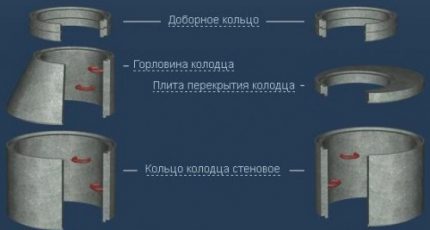
When arranging an absorption well to form a drainage layer, gravel is poured inside with a layer of about half a meter of crushed granite. You can take limestone (dolomite) stone, but it will last no more than 20 years and can lead to salinization of soils.Crushed stone should be medium in size in a few centimeters. Smaller fractions are simply compressed, ceasing to drain water.
Option # 2: Tire Drain Pit
Car tires made of rubber are not susceptible to corrosion, do not crack in the cold and do not break when the soil is heaving. They make an excellent cesspool. But before make a sewer well out of tires worth seriously thinking.
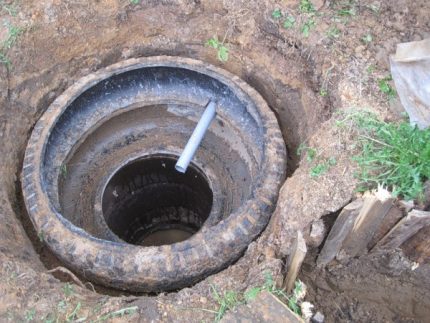
If at least one of the tires leaks out, you will have to dig up and shift the entire well structure again. It is impossible to replace or repair it in any way.
Plus, it is impossible to ensure the tightness of the joints between the tires. You can use various sealants, but due to thermal expansion, the rubber will still “breathe” slightly throughout the year, destroying the sealing layer.
Such a well structure is suitable as a sewer for a small house for one or two people or a summer house with irregular visits. But if you want to clean the effluents produced by a larger family, then it is worth choosing a more productive and larger structure.
Option # 3: plastic construction
The easiest way to install factory-made plastic containers. Their price is higher than that of a reinforced concrete analogue. But then, how much time and effort can be saved on installing such a sewer well with your own hands. Due to the low weight of the structure, a crane is not required; you can lower it into a pit together.

Sewer wells made of plastic are available in various sizes and heights. You can always find an option for the right amount. It is better to choose a body with stiffeners and reliable fastenings for the concrete “anchor” under it.
If plastic well do not fix securely on the bottom of the pit on a concrete base, then it can be squeezed out of the ground during heaving and floods. The lightweight design makes installation easier, but leads to problems with ascent.
If a sealed version is installed, then there are zero problems. It will only be necessary to fill a slab of concrete with a thickness of 15–20 cm at the bottom of the pit, laying iron hooks in the solution for attaching the body.
But when installing a well with drainage in place of the bottom will have to tinker. It will be necessary to make a reliable heavy foundation, which would not block the access of drained water to the ground. You will have to install an additional concrete ring down or pour something similar with your own hands.
Conclusions and useful video on the topic
Video # 1. How to make a cesspool of tires on your own:
Video # 2. Stages of building a sewer well from concrete rings:
Video # 3. How to properly fasten well rings made of concrete:
You can make your own sewer well from various building materials with a minimum of effort and money. There are no difficulties here, the main thing is to correctly design the entire sewage system and correctly choose a place on the site for its external component.
The sewage tank can be masked on top with a removable flowerbed or artificial boulder.
Tell us how you arranged the sewer well in your own summer cottage. Please write comments in the block below. Share your impressions, step-by-step photos of the construction process, ask questions.

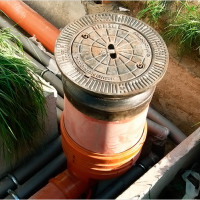 How to make a drainage well with your own hands and bring pipes to it
How to make a drainage well with your own hands and bring pipes to it 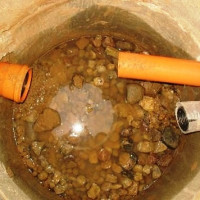 Filter well: design, purpose, device technology
Filter well: design, purpose, device technology 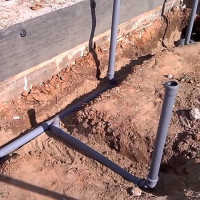 Do-it-yourself sewerage for a bath: diagram and step-by-step instruction on the device
Do-it-yourself sewerage for a bath: diagram and step-by-step instruction on the device 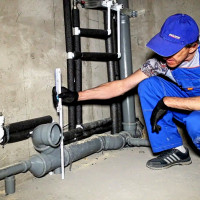 Do-it-yourself replacement of sewage in the apartment: detailed instructions for replacing the riser and pipes
Do-it-yourself replacement of sewage in the apartment: detailed instructions for replacing the riser and pipes 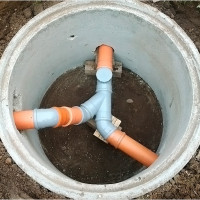 Manhole for sewage: installation of a well in storm and sewage systems
Manhole for sewage: installation of a well in storm and sewage systems 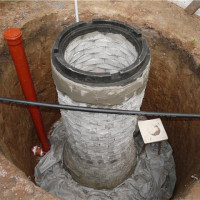 How and what is the waterproofing of sewer wells
How and what is the waterproofing of sewer wells  How much does it cost to connect gas to a private house: the price of organizing gas supply
How much does it cost to connect gas to a private house: the price of organizing gas supply  The best washing machines with dryer: model rating and customer tips
The best washing machines with dryer: model rating and customer tips  What is the color temperature of light and the nuances of choosing the temperature of the lamps to suit your needs
What is the color temperature of light and the nuances of choosing the temperature of the lamps to suit your needs  Replacement of a geyser in an apartment: replacement paperwork + basic norms and requirements
Replacement of a geyser in an apartment: replacement paperwork + basic norms and requirements
I had seen enough of how the hired workers made a sewer from a neighbor. After them, he himself had to redo everything and write a statement to the authorities (an agreement was concluded). I decided to do it myself. At first I considered a septic tank, but the price is just wow, it's not worth it. It is good that our land is not swampy, for a month, of course, with the help of friends, I made sewers from bricks and stones, laid pipes. For me it turned out so well.
I had an idea to make a well for the sewer myself. But now I realized that a person can’t master this without preparation and experience. Especially alone, you need to connect friends. We also have swampy land, which creates additional difficulties both during digging and when installing drainage. Better hire people. And so that later there would be no problems, you need to find craftsmen through friends, then there is a guarantee that everyone will do well.